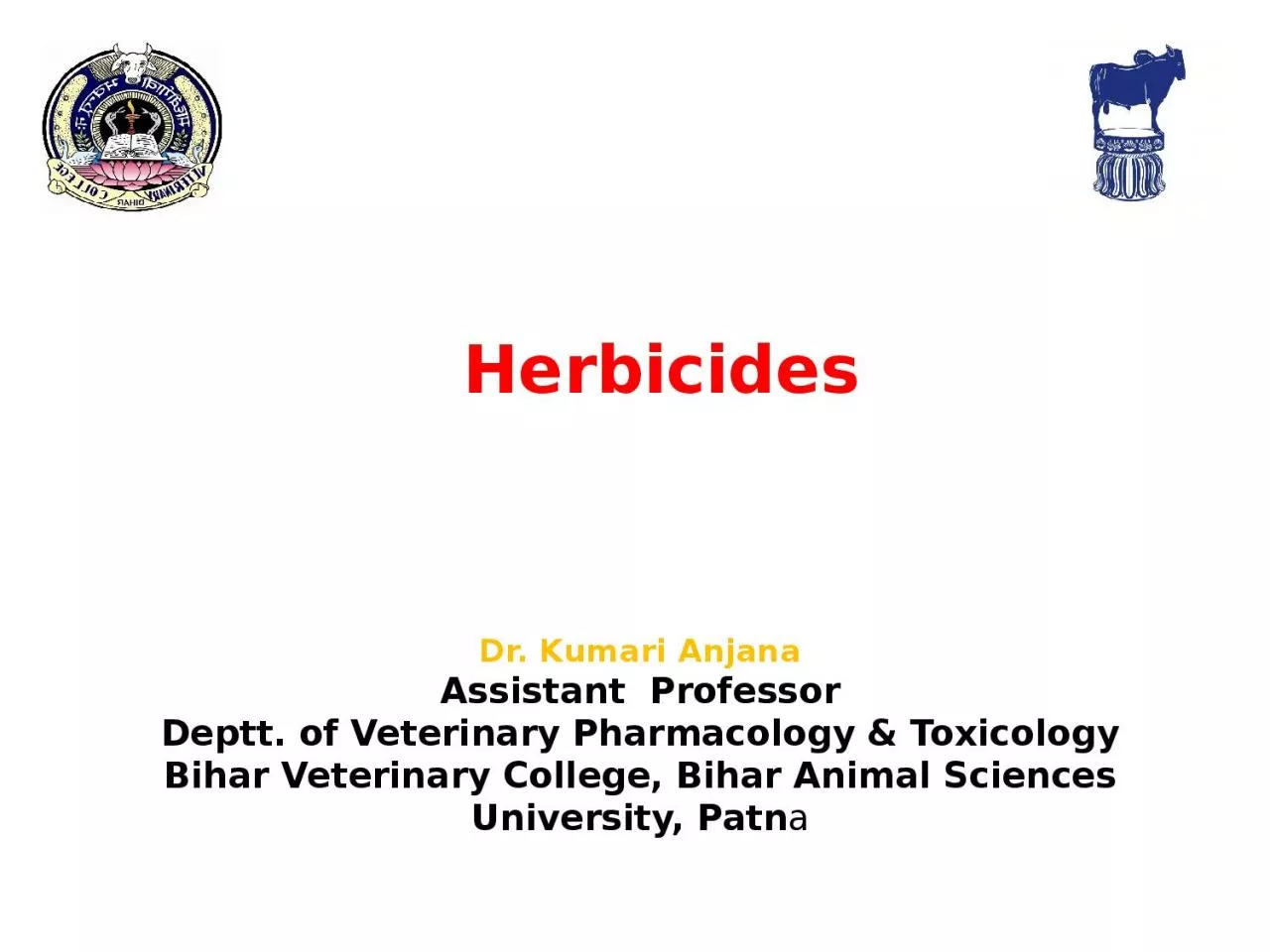

Anjana Assistant Professor Deptt of Veterinary Pharmacology amp Toxicology Bihar Veterinary College Bihar Animal Sciences University Patn a Content of the chapter Introduction Classification ID: 927485
Download Presentation The PPT/PDF document "Herbicides Dr. Kumari" is the property of its rightful owner. Permission is granted to download and print the materials on this web site for personal, non-commercial use only, and to display it on your personal computer provided you do not modify the materials and that you retain all copyright notices contained in the materials. By downloading content from our website, you accept the terms of this agreement.
Slide1
Herbicides
Dr.
Kumari
Anjana
Assistant Professor
Deptt
. of Veterinary Pharmacology & Toxicology
Bihar Veterinary College, Bihar Animal Sciences University, Patn
a
Slide2Content of the chapter Introduction
ClassificationMechanism of action
Clinical signsDiagnosisTreatment
Slide3Herbicide
IntroductionHerbicides are used routinely to control noxious plants.
Most of these chemicals, particularly the more recently developed
synthetic organic herbicides, are quite selective for specific plants and have low toxicity for mammals
; other less selective compounds (e.g. arsenicals, chlorates, dinitrophenols) are more toxic to animals.
Slide4Most toxicity problems in animals result from exposure to excessive quantities of herbicides because of
improper or careless use or disposal of containers: When used properly, problems are rare.
Vegetation treated with herbicides at proper rates normally will not be hazardous to animals
, including humans.
Particularly after the herbicides have
dried on the vegetation, only small amounts can be dislodged.
Slide5When herbicide applications have been excessive
, damage to lawns, crops, or other foliage is often evident.
The residue potential
for most of these agents is
low.
However, the possibility of residues should be explored if significant exposure of food-producing animals occurs.
Herbicide poisoning is a
rare
finding in veterinary practice. With few exceptions, it is only when animals gain direct access to the product that acute poisoning occurs.
Acute signs usually will not lead to a diagnosis, although acute GI signs are frequent.
Slide6Classification of Herbicides
2 major groups: Inorganic Herbicides
Arsenicals- Sodium arsenite Chlorates- Sodium chlorates
Organic Herbicides
Slide7Organic Herbicides
On the basis of chemical nature:
Dinitro compound- dinitro
ortho
cresol (DNOC),
dinitrophenol
Phenoxyacetic acids
- 2,4-D, 2,4,5-T etc.
Bipyridium compounds-
diquat, paraquat etc.
Heterocyclic compounds or triazenes-
atrazine, propazine, simizine.
Chloroaliphatic
acids
- dalapon, sodium chloroacetate,
sodium
trichoroacetate
etc.
Substituted urea
- monouron, diuron,
isoproturon
etc.
Substituted
dinitroaniline
-
pendimethalin
.
Slide8Mechanism of Toxicosis:
Not known. These uncouple oxidative phosphorylation and depress ribonuclease synthesis.
Cause cytotoxicity to visceral and reproductive organs. Interfere with neuromuscular transmission. Increase HCN and nitrate content and palatability of such plants.
Signs and Symptoms: Anorexia, diarrhoea, muscle weakness,
incoordiantion
and metabolic acidosis.
Slide9Sources
Accidental ingestion of herbicide spills. Improper disposal of herbicide spills. Grazing in recently herbicide-sprayed fields.
Malicious poisoning.
Slide10Chlorophenoxy Compounds (Phenoxyacetic acid compounds)
The most important and most frequently used herbicides.
It can potentiate the toxic effects of some plants .
Increases the nitrate content of certain plants and increases the palatability of certain toxic plants, thus increases the poisoning risk.
Dogs are most sensitive animals.
Slide11Bipyridal/
Bipyridinium Compounds
Slide12Paraquat is a very reactive compound.
It is actively taken up by the alveolar cells via a diamine where it readily accepts an electron from NADPH to become reduced paraquat.
When the reduced paraquat is reoxidized by loss of electron, a superoxide anion radical O
2
- is generated.
The
superoxide radical is unstable and spontaneously breaks down to the reactive singlet oxygen
.
The
reactive singlet oxygen attacks the polyunsaturated lipids associated with cell membranes to form lipid hydroperoxides.
Slide13These lipid hydroperoxides are normally converted to non toxic lipid alcohols by the selenium – containing enzyme glutathione
peroxidase. Selenium deficiency, depletion of glutathione or excess lipid hydroperoxides allow the
lipid hydroperoxides to form lipid free radicals.
The action of
paraquat
in lungs
is similar to that produced by
carbon tetrachloride in liver
.
Slide14Small amount of superoxide that are produced normally in tissues are also scavenged by superoxide dismutase, an enzyme that converts superoxide to H2
O2
The H2O
2
is detoxified by
catalase
or glutathione
peroxidases
.
If the detoxification of H
2
O
2
does not happen fast enough, the H2O2 may form highly reactive hydroxyl radical.
Lungs tissue is deficient in super oxide dismutase, so it is more susceptible to the excess
superoxides
generated by
paraquqte
.
Slide15Signs and Symptoms
Anorexia, abdominal pain, vomiting,
pulmonary oedema, dyspnoea, jaundice,
tachycardia,
corneal opacity,
ulceration of mm, skin, cyanosis.
Slide16Dinitrophenol Derivatives
The dinitro
phenol derivatives possess: insecticidal, fungicidal, acaricidal
herbicidal actions.
It highly toxic to mammals.
Slide17Machanism of Toxicosis
:
These uncouple oxidative phosphorylation. In ruminants – the dinitro
derivatives are converted to nitrates, which in turn to nitrites, which after absorption cause
methaemoglobinemia
. Deplete liver glycogen.
Signs and Symptoms:
Hyperthermia, dyspnoea, acidosis, tachycardia, convulsions, coma and death. Yellow skin, conjunctiva or hair. Corneal opacity (cataract).
Slide18Sodium Chlorate: Rarely used. Causes
hemolysis and methaemoglobin formation.
Chlorobenzoic
acid derivatives:
2,3,6 –
Trichlorobenzoic
acid (2,3,6-TBA).
Mechanism of Toxicosis: Not known.
Signs and symptoms: Like
Chlorophenoxy
compounds.
Slide19TreatmentNo specific antidotes. Symptomatic and supportive treatment.
Slide20Thank You